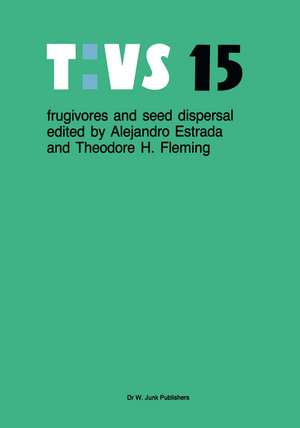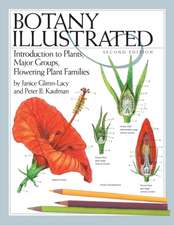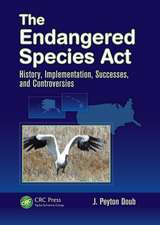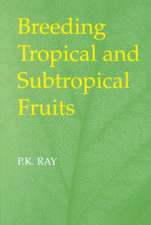Frugivores and seed dispersal: Tasks for Vegetation Science, cartea 15
Editat de Alejandro Estrada, T. H. Flemingen Limba Engleză Paperback – 26 sep 2011
| Toate formatele și edițiile | Preț | Express |
|---|---|---|
| Paperback (1) | 1825.75 lei 43-57 zile | |
| SPRINGER NETHERLANDS – 26 sep 2011 | 1825.75 lei 43-57 zile | |
| Hardback (1) | 1833.33 lei 43-57 zile | |
| SPRINGER NETHERLANDS – 30 iun 1986 | 1833.33 lei 43-57 zile |
Din seria Tasks for Vegetation Science
-
 Preț: 34.59 lei
Preț: 34.59 lei - 18%
 Preț: 1219.16 lei
Preț: 1219.16 lei - 20%
 Preț: 554.66 lei
Preț: 554.66 lei -
 Preț: 394.12 lei
Preț: 394.12 lei -
 Preț: 396.02 lei
Preț: 396.02 lei -
 Preț: 402.76 lei
Preț: 402.76 lei - 24%
 Preț: 790.13 lei
Preț: 790.13 lei - 18%
 Preț: 1218.69 lei
Preț: 1218.69 lei - 24%
 Preț: 784.53 lei
Preț: 784.53 lei - 18%
 Preț: 1233.69 lei
Preț: 1233.69 lei -
 Preț: 73.90 lei
Preț: 73.90 lei - 18%
 Preț: 1222.01 lei
Preț: 1222.01 lei - 18%
 Preț: 952.09 lei
Preț: 952.09 lei - 18%
 Preț: 1225.94 lei
Preț: 1225.94 lei -
 Preț: 388.31 lei
Preț: 388.31 lei -
 Preț: 391.40 lei
Preț: 391.40 lei - 18%
 Preț: 1220.45 lei
Preț: 1220.45 lei - 18%
 Preț: 949.23 lei
Preț: 949.23 lei - 18%
 Preț: 943.73 lei
Preț: 943.73 lei - 18%
 Preț: 1238.11 lei
Preț: 1238.11 lei - 18%
 Preț: 1232.26 lei
Preț: 1232.26 lei - 24%
 Preț: 796.72 lei
Preț: 796.72 lei - 24%
 Preț: 1068.94 lei
Preț: 1068.94 lei -
 Preț: 368.39 lei
Preț: 368.39 lei - 18%
 Preț: 1230.03 lei
Preț: 1230.03 lei - 24%
 Preț: 783.41 lei
Preț: 783.41 lei - 18%
 Preț: 948.16 lei
Preț: 948.16 lei - 18%
 Preț: 948.61 lei
Preț: 948.61 lei - 24%
 Preț: 1053.39 lei
Preț: 1053.39 lei
Preț: 1825.75 lei
Preț vechi: 2226.53 lei
-18% Nou
Puncte Express: 2739
Preț estimativ în valută:
349.35€ • 365.73$ • 289.07£
349.35€ • 365.73$ • 289.07£
Carte tipărită la comandă
Livrare economică 07-21 aprilie
Preluare comenzi: 021 569.72.76
Specificații
ISBN-13: 9789401086332
ISBN-10: 9401086338
Pagini: 408
Ilustrații: XIV, 392 p.
Dimensiuni: 178 x 254 x 21 mm
Greutate: 0.7 kg
Ediția:Softcover reprint of the original 1st ed. 1986
Editura: SPRINGER NETHERLANDS
Colecția Springer
Seria Tasks for Vegetation Science
Locul publicării:Dordrecht, Netherlands
ISBN-10: 9401086338
Pagini: 408
Ilustrații: XIV, 392 p.
Dimensiuni: 178 x 254 x 21 mm
Greutate: 0.7 kg
Ediția:Softcover reprint of the original 1st ed. 1986
Editura: SPRINGER NETHERLANDS
Colecția Springer
Seria Tasks for Vegetation Science
Locul publicării:Dordrecht, Netherlands
Public țintă
ResearchCuprins
1: Plant strategies.- 1. Vertebrate-dispersed plants: why they don’t behave the way they should.- 2. A seven-year study of individual variation in fruit production in tropical bird-dispersed tree species in the family Lauraceae.- 3.Spatial components of fruit display in understory trees and shrubs.- 4.Seed deposition patterns: influences of season, nutrients, and vegetation structure.- 5. Foliar ‘flags’ for avian frugivores: signal or serendipity?.- 6. Dispersal of seeds by animals: effect on lightcontrolled dormancy in Cecropia obtusifolia.- 2: Frugivore strategies.- 7. Selection on plant fruiting traits by brown capuchin monkeys: a multivariate approach.- 8. Frugivory in howling monkeys (Alouatta palliata) at Los Tuxtlas, Mexico: dispersal and fate of seeds.- 9. Opportunism versus specialization: the evolution of feeding strategies in frugivorous bats.- 10. Inter-relations between frugivorous vertebrates and pioneer plants: Cecropia, birds and bats in French Guyana.- 11. The influence of morphology on fruit choice in neotropical birds.- 12. Methods of seed processing by birds and seed deposition patterns.- 13. Some aspects of avian frugivory in a north temperate area relevant to tropical forest.- 3: The consequences of seed dispersal.- 14. Seed dispersal and environmental heterogeneity in a neotropical herb: a model of population and patch dynamics.- 15. Consequences of seed dispersal for gap-dependent plants: relationships between seed shadows, germination requirements, and forest dynamic processes.- 16. Seed dispersal mutualism and the population density of Asarum canadense, an ant-dispersed plant.- 17. The influence of seed dispersal mechanisms on the genetic structure of plant populations.- 18. Seed dispersal by birds and squirrels in the deciduous forestsof the United States.- 19. Seed shadows, seed predation and the advantages of dispersal.- 20. Mice, big mammals, and seeds: it matters who defecates what where.- 21. Seed predation and dispersal in a dominant desert plant: Opuntia, ants, birds, and mammals.- 22. Agoutis (Dasyprocta punctata), the inheritors of guapinol (Hymenaea courbaril: Leguminosae).- 4: Community aspects of frugivory and seed dispersal.- 23. Relationships between dispersal syndrome and characteristics of populations of trees in a subtropical forest.- 24. Seed dispersal, gap colonization, and the case of Cecropia insignis.- 25. Seed dispersal, gap dynamics and tree recruitment: the case of Cecropia obtusifolia at Los Tuxtlas, Mexico.- 26. Constraints on the timing of seed germination in a tropical forest.- 27. Dispersal and the sequential plant communities in Amazonian Peru floodplain.- 28. Community aspects of frugivory in tropical forests.
Recenzii
`This book is a must for every seed dispersal ecologist, and is, therefore, higly recommended.'
S. Godschalk, South American Journal on Zoology, 1989.
`... this book is a valuable source of information and methodological approaches for all students who are and will be attracted by this field of modern ecology.'
L. Klimes, Folia Geobotanica et Phytotaxonomica, Vol. 24, 1989.
S. Godschalk, South American Journal on Zoology, 1989.
`... this book is a valuable source of information and methodological approaches for all students who are and will be attracted by this field of modern ecology.'
L. Klimes, Folia Geobotanica et Phytotaxonomica, Vol. 24, 1989.












